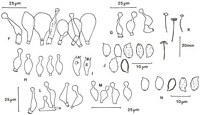|
 Conocybe horakii Conocybe horakii
BiostatusPresent in region - Indigenous. Endemic
Images (click to enlarge)
Caption: F-K Horak 68/66 holotype, F. Pileipellis; G. Caulocystidia; H. Cheilocystidia; I. Basidia; J. Basidiospores; K. Habit sketch and section. L-N Horak 69/24, L. Caulocystidia; M. Cheilocystidia; N. Basidiospores. |
Article: Watling, R.; Taylor, G.M. (1987). Observations on the Bolbitiaceae: 27. Preliminary account of the Bolbitiaceae of New Zealand. Bibliotheca Mycologica 117: 61 p. + 17 pl.
Description: Pileus 3-5-8.5 mm, hemispheric to convex, becoming expanded to flat, dark brown, argillaceous or honey brown at disc, colour fading towards margin and on drying, surface dry, glabrous; margin conspicuously striate sometimes subsulcate with age. Stipe 11-23 x 0.5 mm, equal, pale ochraceous or argillaceous becoming darker rust-brown with age, apex pruinose otherwise glabrous, appressed fibrillose towards base, dry, hollow, brittle, with weft of white hyphae at base. Gills free, subventricose, intense rust-brown, L 8-12, 13, with
Basidiospores 6.5-7.5 x 3.5-4 µm. amygdaliform in side-view, slightly drawn out at germ-pore, minutely punctate (asperulate), slightly thick-walled, non-amyloid, ochraceous tawny in water, slightly darker in aqueous alkali; germ-pore distinct. Basidia 4-spored, clavate with short pedicel, hyaline in water and alkali solutions. Cheilocystidia lecythiform, 18-25 x 8-10 µm, capitulum 3.5-5.5 µm. hyaline; pleurocystidia absent. Pileipellis a palisadoderm with or without dermatocystidia, composed of generally smooth spheropedunculate cells 15-18(-20) µm broad, sometimes with slightly roughened pedicels; pilocystidia when present, lecythiform, narrow, and slightly pigmented, sometimes even tibiiform in overall shape. Stipitipellis of cylindric cells covered especially at apex with groups of tibiiform to lecythiform caulocystidia 15.25 x 6-8(-10) µm, generally narrower and longer than cheilocystidia. Clamp-connections present.
|